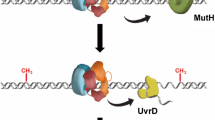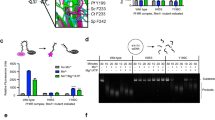Abstract
DNA mismatch repair (MMR) proteins maintain genetic integrity in all organisms by recognizing and repairing DNA errors. Such alteration of hereditary information can lead to various diseases, including cancer. Besides their role in DNA repair, MMR proteins detect and initiate cellular responses to certain type of DNA damage. Its response to the damaged DNA has made the human MMR pathway a useful target for anticancer agents such as carboplatin. This study indicates that strong, specific interactions at the interface of MutSα in response to the mismatched DNA recognition are replaced by weak, non-specific interactions in response to the damaged DNA recognition. Data suggest a severe impairment of the dimerization of MutSα in response to the damaged DNA recognition. While the core of MutSα is preserved in response to the damaged DNA recognition, the loss of contact surface and the rearrangement of contacts at the protein interface suggest a different packing in response to the damaged DNA recognition. Coupled in response to the mismatched DNA recognition, interaction energies, hydrogen bonds, salt bridges, and solvent accessible surface areas at the interface of MutSα and within the subunits are uncoupled or asynchronously coupled in response to the damaged DNA recognition. These pieces of evidence suggest that the loss of a synchronous mode of response in the MutSα’s surveillance for DNA errors would possibly be one of the mechanism(s) of signaling the MMR-dependent programed cell death much wanted in anticancer therapies. The analysis was drawn from dynamics simulations.










Similar content being viewed by others
References
Kunkel TA (1992) DNA replication fidelity. J Biol Chem 267:18251–18254
Iyer RR, Pluciennik A, Burdett V, Modrich PL (2006) DNA mismatch repair: functions and mechanisms. Chem Rev 106:302–323
Peltomaki P (2003) Role of DNA mismatch repair deffects in the pathogenesis of human cancer. J Clin Oncol 21:1174–1179
Wang D, Lippard SJ (2005) Cellular processing of platinum anticancer drugs. Nature 4:307–321
Vasilyeva A, Clodfelter JE, Reactor B, Hills T, Scarpinato KD, Salsbury FR Jr (2009) Small molecule induction of Msh2-dependent cell death suggests a vital role of mismatch repair proteins in cell death. DNA Repair 8:103–113
Salsbury FR Jr, Clodfelter JE, Gentry MB, Hollis T, Scarpinato Drotschman K (2006) The molecular mechanism of DNA damage recognition by MutS homologs and its consequences for cell death response. Nucleic Acids Res 34:2173–2185
Vasilyeva A, Clodfelter JE, Gorczynski MJ, Gerardi AR, King SB et al. (2010) Parameters of reserpine analogs that induce MSH2/MSH6-dependent cytotoxic response. J Nucleic Acids. doi:10.4061/2010/162018
Fukui K, Shimada A, Iino H, Masui R, Kuramitsu S (2011) Biochemical properties of MutL, a DNA mismatch repair endonuclease. In: Storici F (ed) DNA repair - on the pathways to fixing DNA damage and errors. In Tech. doi:10.5772/23758
Gupta S, Gellert M, Yang W (2012) Mechanism of mismatch recognition revealed by human MutSβ bound to unpaired DNA loops. Nat Struct Mol Biol 19:72–79
Qiu R, DeRocco VC, Harris C, Sharma A, Hingorani MM, Erie DA, Weninger KR (2012) Large conformational changes in MutS during DNA scanning, mismatch recognition and repair signaling. EMBO J 31:2528–2540
Duckett DR, Drummond JT, Alastair IH, Murchie AIH, Reardon JT et al. (1996) Human MutSalpha recognizes damaged DNA base pairs containing 06-methylguanine, 04-methylthymine, or the cisplatin-d(GpG) adduct. Proc Natl Acad Sci U S A 93:6443–6447
Mello JA, Acharya S, Fishel R, Essigmann JM (1996) The mismatch-repair protein hMSH2 binds selectively to DNA adducts of the anticancer drug cisplatin. Chem Biol 3:579–589
Jiricny J (2006) The multifaceted mismatch-repair system. Nat Rev Mol Cell Biol 7:335–346
Kelland L (2007) The resurgence of platinum-based cancer chemotherapy. Nature 7:573–584
Drotschmann K, Topping RP, Clodfelter JE, Salsbury FR Jr (2004) Mutations in the nucleotide-binding domain of MutS homologs uncouple cell death from cell survival. DNA Repair (Amst) 3:729–742
Harrap KR (1985) Preclinical studies identifying carboplatin as a viable cisplatin alternative. Cancer Treat Rev 12:21–33
Rosenberg B, Van Camp L, Krigas T (1965) Inhibition of cell division in Escherichia coli by electrolysis products from a platinum electrode. Nature 205:698–699
Wheate NJ, Walker S, Craig GE, Onun R (2010) The status of platinum anticancer drugs in the clinic and in clinical trials. Dalton Trans 39:813–827
Andrews P, Howell S (1990) Cellular pharmacology of cisplatin: perspectives on mechanisms of acquired resistance. Cancer Cells 2:35–43
Shirazi FH, Wong PTT, Goel R (2003) Interaction of cisplatin with cellular macromolecules: a fourier transform infrared spectroscopy study. Iran J Pharm Res 2:11–15
Takahara PM, Rosenzweig AC, Frederick CA, Lippard SJ (1995) Crystal structure of double-stranded DNA containing the major adduct of the anticancer drug cisplatin. Nature 377:649–652
Teuben JM, Bauer C, Wang AHJ, Reedijk J (1999) Solution structure of a DNA duplex containing a cis-diammineplatinum(II) 1,3-d(GTG) intrastrand cross-link, a major adduct in cells treated with the anticancer drug carboplatin. Biochemistry 38:12305–12312
Wolfe KC, Hastings WA, Dutta S, Long A, Shapiro BA et al. (2012) Multiscale modeling of double-helical DNA and RNA: a unification through lie groups. J Phys Chem B. doi:10.1021/jp2126015
Kartalou M, Essigmann JM (2001) Recognition of cisplatin adducts by cellular proteins. Mutat Res 478:1–21
Jamieson ER, Lippard SJ (1999) Structure, recognition, and processing of cisplatin-DNA adducts. Chem Rev 99:2467–2498
Negureanu L, Salsbury FR Jr (2012) Insights into protein-DNA interactions, stability and allosteric communications: a computational study of MutSα-DNA recognition complexes. J Biomol Struct Dyn 29:757–776
Negureanu L, Salsbury FR Jr (2012) The molecular origin of the MMR-dependent apoptosis pathway from dynamics analysis of MutSα-DNA complexes. J Biomol Struct Dyn 30:347–361
Warren JJ, Pohlhaus TJ, Changele A, Iyer RR, Modrich PL et al. (2007) Structure of the human MutS DNA lesion recognition complex. Mol Cell 26:579–592
Brooks B, Bruccoleri RE, Olafson BD, States DJ, Swaminatan S et al. (1983) CHARMM: a program for macromolecular energy, minimization, and dynamics calculations. J Comput Chem 4:187–217
Jorgensen WL, Chandrasekhar J, Madura JD, Impey RW, Klein ML (1983) Comparison of simple potential functions for simulated liquid water. J Chem Phys 79:926–935
Humphrey W, Dalke A, Schulten K (1996) VMD: visual molecular dynamics. J Mol Graphics 14:33–38
MacKerell DA Jr, Banavali N, Foloppe N (2001) Development and current status of the CHARMM force field for nucleic acids. Biopolymers 56(257–265)
MacKerell DA Jr, Bashford D, Bellot M, Dunbrack RL, Evanseck JD et al. (1998) All-atom empirical potential for molecular modeling and studies of proteins. J Phys Chem B 102:3586–3616
Scheeff ED, Briggs JM, Hawell SB (1999) Molecular modeling of the intrastrand guanine-guanine DNA adducts produced by cisplatin and oxaliplatin. Mol Pharmacol 56(633–643)
Salsbury FR Jr, Crowley MF, Brooks CL (2001) Modeling of the metallo-beta-lactamase from B-fragilis: structural and dynamic effects of inhibitor binding. Proteins 44:448–459
Knaggs MH, Salsbury Jr FR, Edgell MH, Fetrow JS (2007) Insights into correlated motions and long-range interactions in CheY derived from molecular dynamics simulations. Biophys J:2062–2079
Salsbury FR Jr (2010) Molecular dynamics simulations of protein dynamics and their relevance to drug discovery. Curr Opin Pharmacol 10:738–744
Berendsen HJC, Postma JPM, van Gunsteren WF, DiNola A, Haak JR (1984) Molecular dynamics with coupling to an external bath. J Chem Phys 81:3684–3690
Kale L, Skeel R, Bhandarkar M, Brunner R, Gursoy A et al. (1999) NAMD2: greater scalability for parallel molecular dynamics. J Comput Phys 15:1283–1312
van Gunsteren WF, Berendsen HJC (1977) Algorithms for macromolecular dynamics and constraint dynamics. Mol Phys 34(1311–1327)
Darden T, York D, Pedersen L (1993) Particle Mesh Ewald: an N Log(N) method for Ewald sums in large systems. J Chem Phys 98:10089–10092
Hunenberger P, Mark AE, van Gunsteren WF (1995) Fluctuation and cross-correlation analysis of protein motions observed in nanosecond molecular dynamics simulations. J Mol Biol 252:492–503
Caves LSD, Evanseck JD, Karplus M (1998) Locally accessible conformations of proteins: multiple molecular dynamics simulations of crambin. Protein Sci 7:649–666
Straub JE, Rashkin AB, Thirumalai D (1994) Dynamics in rugged energy landscapes with applications to the S-peptide and ribonuclease. J Am Chem Soc 116:2049–2063
Horita DA, Zhang W, Smithgall TE, Gmeiner WH, Byrd RA (2000) Dynamics of the Hck-SH3 domain: comparison of experiment with multiple molecular dynamics simulations. Protein Sci 9:95–103
Auffinger P, Westhof E (1997) Three ns of multiple molecular dynamics simulations of solvated tRNA(ASP) anticodon hairpin. J Mol Biol 269:326–341
Salsbury FR Jr, Crowder MW, Kingsmore SF, Huntley JJA (2009) Molecular dynamics simulations of the metallo-beta-lactamase from Bacteroides fragilis in the presence and absence of a tight-binding inhibitor. J Mol Model 15:133–145
Loccisano AE, Acevedo O, DeChancie J, Schulze BG, Evanseck JD (2004) Enhanced sampling by multiple molecular dynamics trajectories: carbonmonoxy myoglobin 10 micros A0–>A(1–3 transition from ten 400 picosecond simulations. J Mol Model 22:369–376
Steinbach P, Brooks BR (1994) New spherical-cutoff methods for long-range forces in macromolecular simulations. J Comp Chem 15:667–683
Lee B, Richards FM (1971) The interpretation of protein structures: estimation of static accessibility. J Mol Biol 55:379–400
Chothia C (1976) The nature of the accessible and buried surfaces in proteins. J Mol Biol 105:1–14
Raschke TM, Tsai J, Levitt M (2001) Quantification of the hydrophobic interaction by simulations of the aggregation of small hydrophobic solutes in water. Proc Natl Acad Sci U S A 98:5965–5969
Taylor A, Kennard O (1982) Crystallographic evidence for the existence of C–H–O, C–H–N and C–H Cl hydrogen bonds. J Am Chem Soc 104(5063–5070)
Desiraju GR, Steiner T (1999) The weak hydrogen bond in structural chemistry and biology. Oxford University Press, New York
Jeffrey GA, Saenger W (1991) Hydrogen bonding in biological structures. Springer Verlag, Berlin
Panigrahi SK, Desiraju GR (2007) Strong and weak hydrogen bonds in the protein-ligand interface. Proteins 67:128–142
Barlow D, Thornton JM (1983) Ion-pairs in proteins. J Mol Biol 168:867–885
Karpen M, Tobias DJ, Brooks CL (1993) Statistical clustering techniques for the analysis of long molecular dynamics trajectories: analysis of 2.2-ns trajectories of YPGDV. Biochemistry 32:412–420
Matlab (2010) 7.10.0 edn. The MathWorks Inc., Natick, MA
Negureanu L, Salsbury FR Jr (2013) Non-specificity and synergy at the binding site of the carboplatin-induced DNA adduct via molecular dynamics simulations of the MutSα-DNA recognition complex. J Biomol Struct Dyn. doi:10.1080/07391102.2013.799437
Acknowledgments
This research was partially supported by National Institute of Health R01CA129373 grand to FRS. The computational herein were performed on the Wake Forest University DEAC cluster. We thank Wake Forest University’s Provost’s office and Information Systems Department for their generous support.
Author information
Authors and Affiliations
Corresponding author
Rights and permissions
About this article
Cite this article
Negureanu, L., Salsbury, F.R. Destabilization of the MutSα’s protein-protein interface due to binding to the DNA adduct induced by anticancer agent carboplatin via molecular dynamics simulations. J Mol Model 19, 4969–4989 (2013). https://doi.org/10.1007/s00894-013-1998-2
Received:
Accepted:
Published:
Issue Date:
DOI: https://doi.org/10.1007/s00894-013-1998-2




